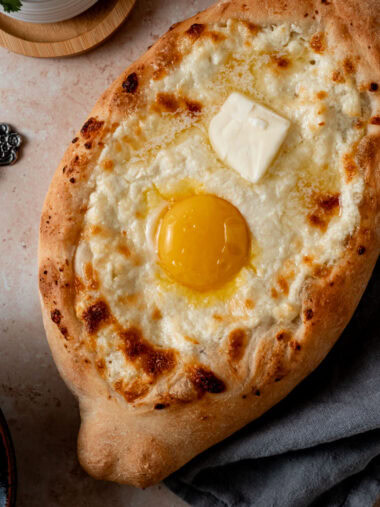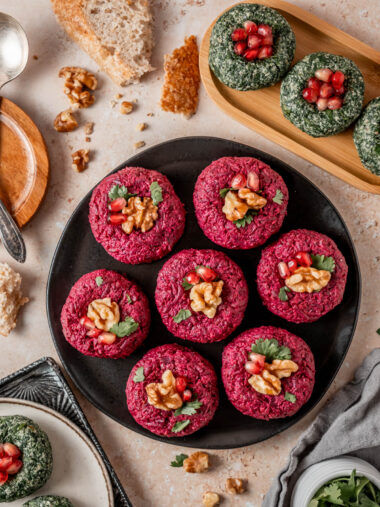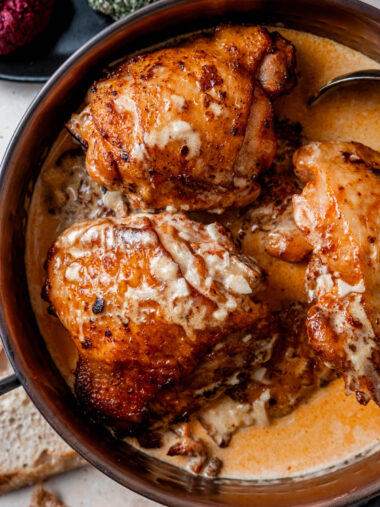This Khinkali recipe features a tender dough filled with a spiced mixture of ground beef and pork swimming in a rich, savory broth!
Khinkali are extremely flavorful Georgian dumplings and a favorite in our household! The dumplings are filled with a rich mixture of ground meat, cilantro and spices all immersed in a flavorful broth.
How do you eat Khinkali? Take a small bite out of the side, slurp up the delicious broth and then finish the rest. Discard the doughy knobs and repeat!
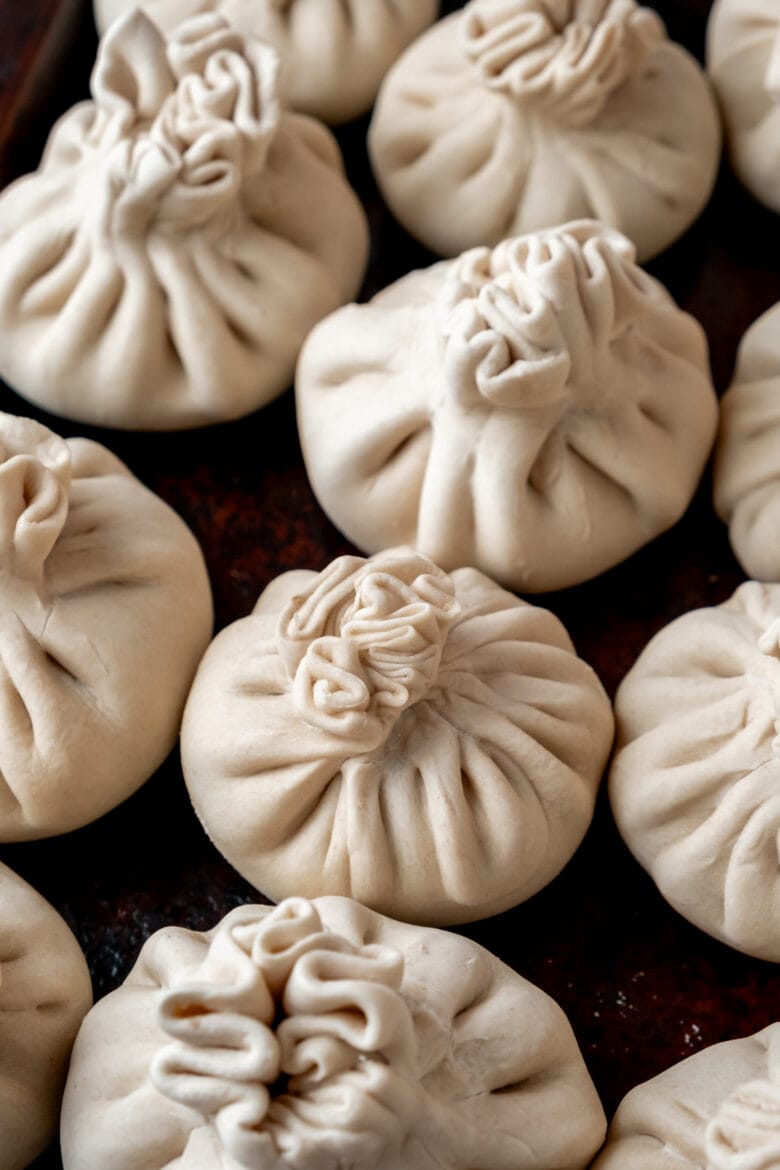
Recipe ingredients
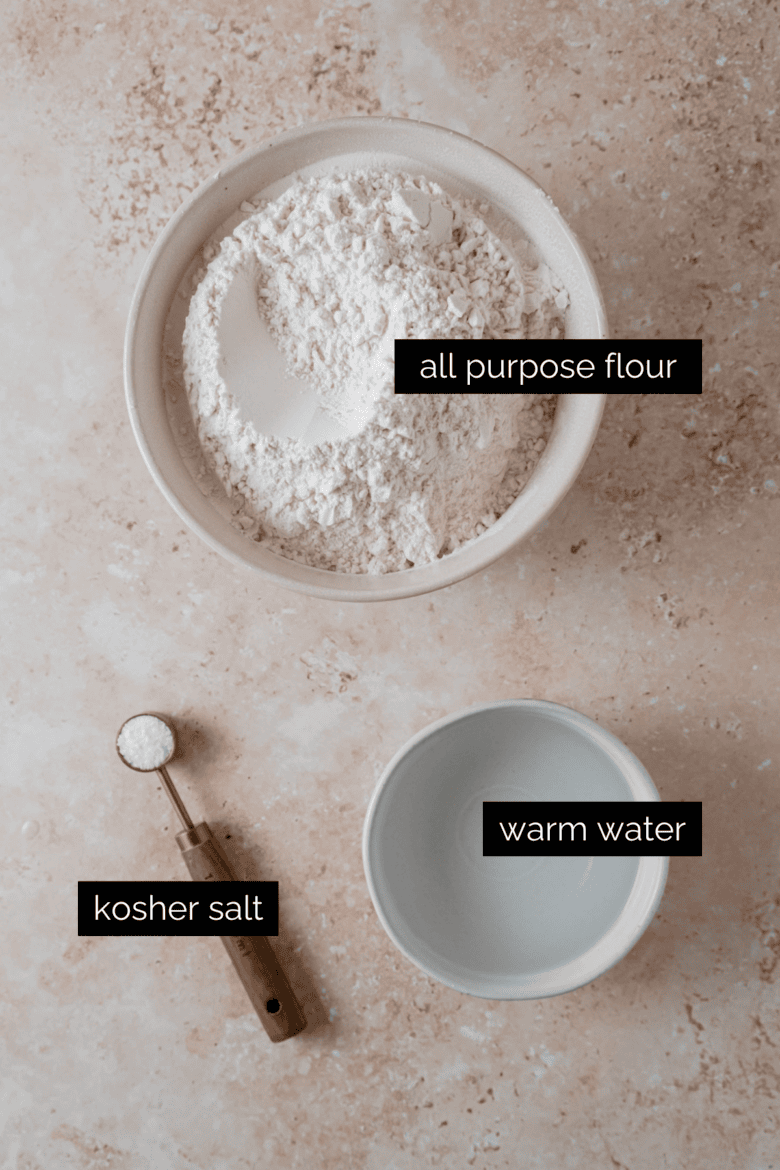
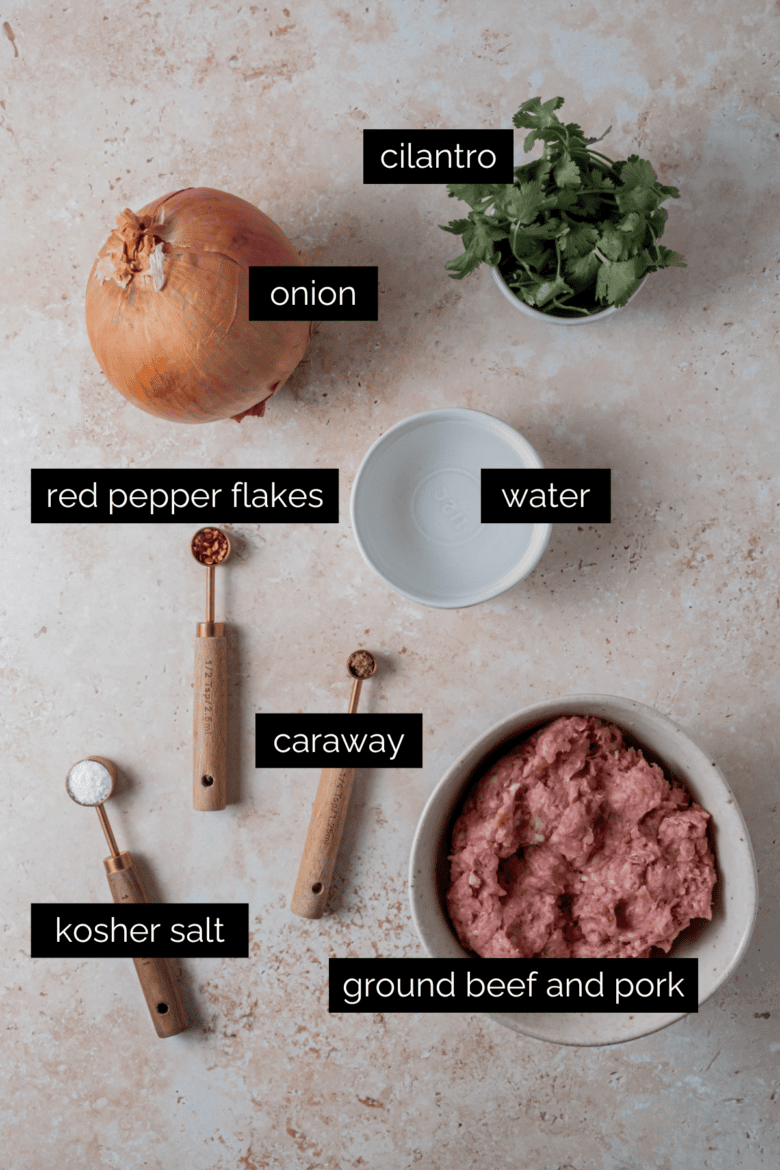
Dough
The dough is made with just three ingredients. We use a minimal amount of water to ensure a sturdy dough that can handle the weight of the brothy filling.
- All purpose flour: Use a kitchen scale when measuring the flour if at all possible. Using cups often leads to over-measuring the flour, which can make your dough too tough to work with.
- Kosher salt: Salt enhances the flavor of the dough.
- Warm water: We’re not looking for hot water — slightly warm water from your kitchen sink is perfect.
Filling
- Ground beef and pork: I like to use a 50/50 mixture of ground beef and pork, but you could use one or the other if you prefer.
- Yellow onion: Grate the yellow onion on the large holes of a box grater or use a food processor to finely chop. Make sure to add any liquid to the filling.
- Cilantro: I use one whole bunch of cilantro. Make sure to use both leaves and thin stems. The stems have so much flavor!
- Salt and spices: To season the Khinkali, I use salt, red pepper flakes and ground caraway seeds. If you can’t find caraway, feel free to leave it out.
- Water: Adding water to the meat mixture creates the broth that is essential to making soup dumplings.
A note on caraway: Caraway is often mistranslated as cumin in Georgian recipes, as the name for caraway is often a variation on the name for cumin. The seeds even look somewhat similar! When making Khinkali, always opt for caraway over cumin.
Variations and substitutions
Experiment with different meats. Lamb, pork and beef are all great choices for the filling. Use one meat or a combination of two different meats.
Add more spice. An extra half teaspoon of red pepper flakes will add a bit more heat to your Khinkali. Or try a teaspoon of our homemade Khmeli Suneli spice mix.
Season with black pepper. Fun fact? I’m allergic to black peppercorn. But black pepper is often found in Khinkali, so feel free to add 1/4 teaspoon to the filling if that’s your thing.
Step by step instructions and photos
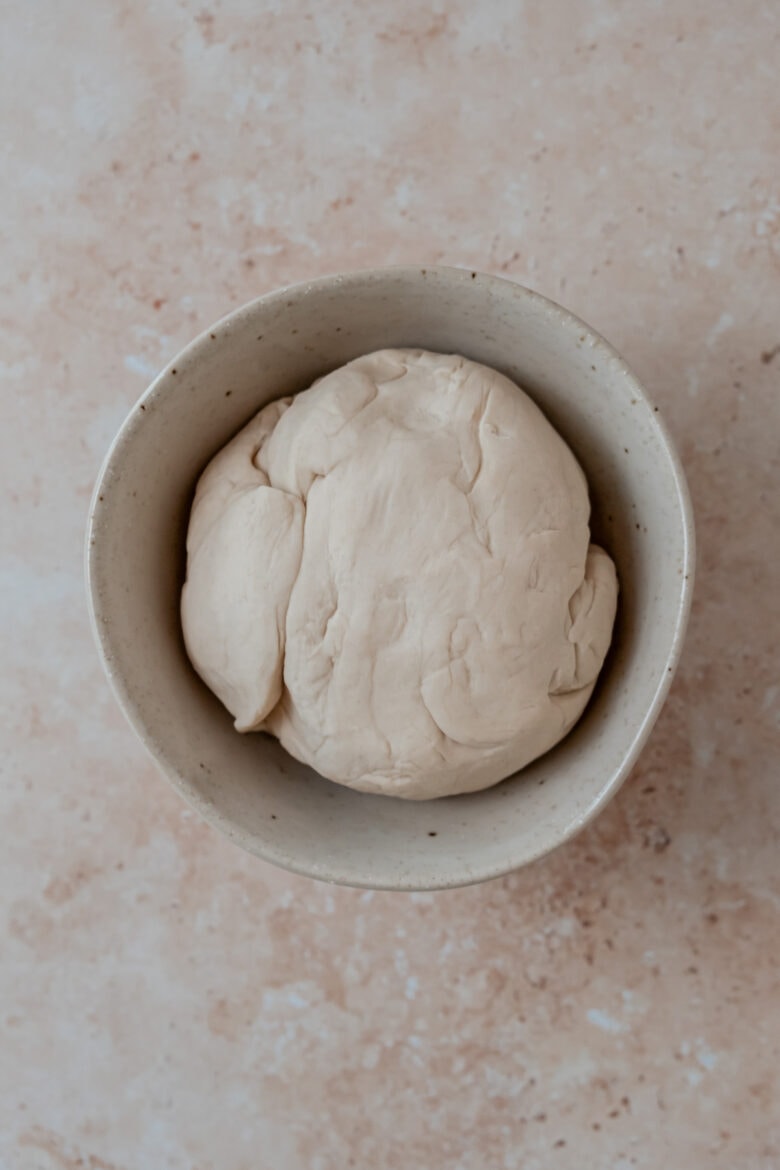
Step 1: Make the dough. The dough will be very firm and quite difficult to knead. That’s exactly what we want! Let the dough rest covered at room temperature for two hours and the texture will change completely.
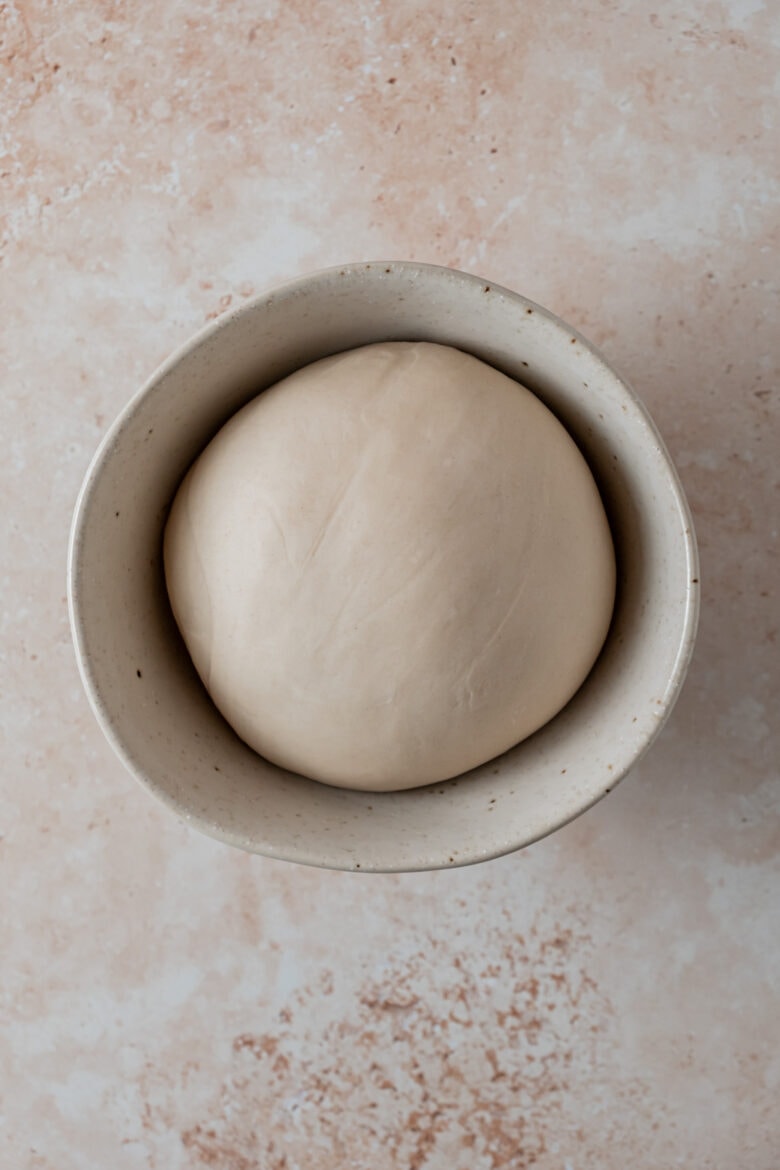
Step 2: Let the dough rest. As the dough rests, the flour will hydrate and the gluten will become more relaxed. See that picture above? The dough is soft and pliable — completely different from a few hours ago. The rest time makes such a difference so don’t skip it!
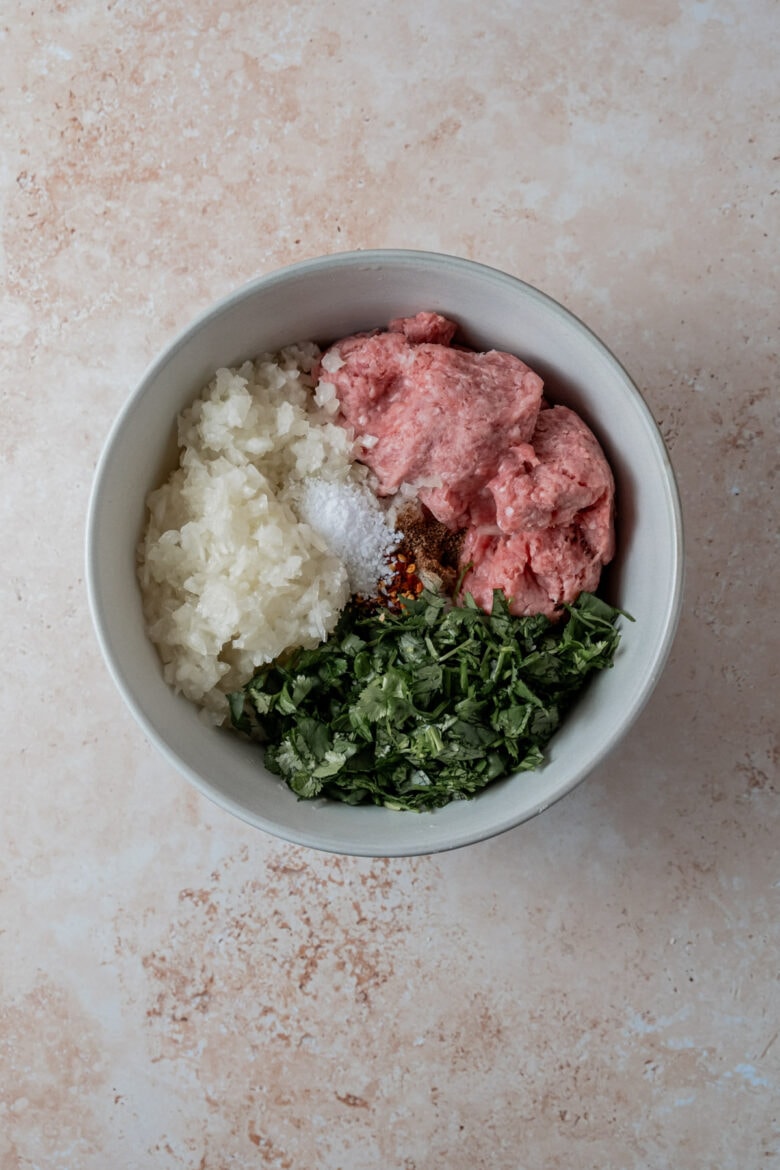
Step 3: Mix the meat filling. Combine all the ingredients for the filling (minus the water) in a bowl and mix well.
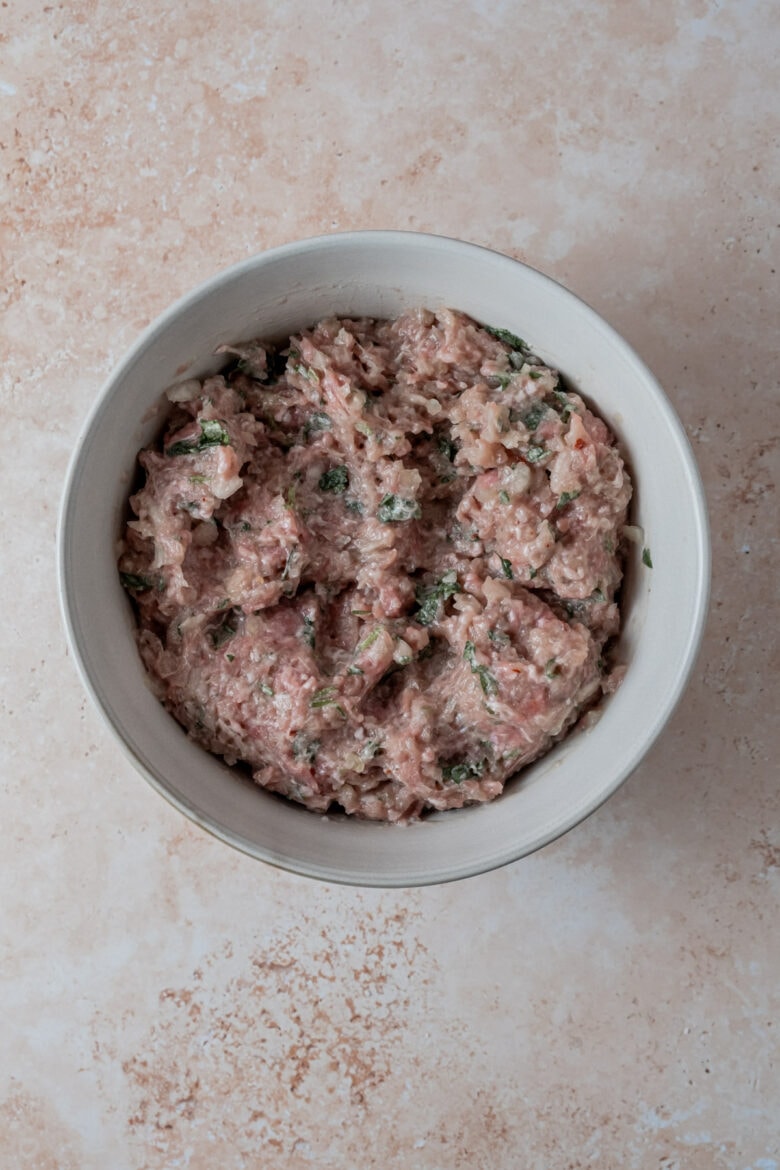
Step 4: Add water and knead. Adding water to the filling creates a delicious broth inside the dumpling. Knead the water into the filling until it has been absorbed, meaning there’s no liquid pooled at the bottom of the bowl.
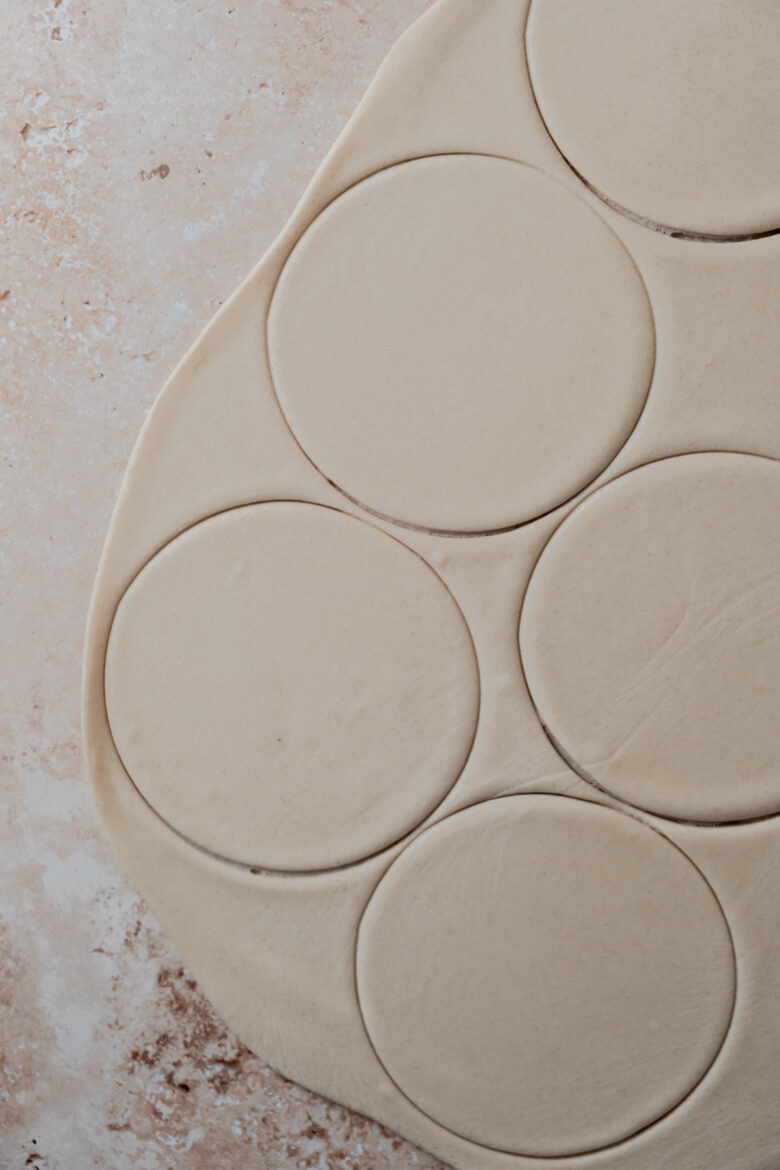
Step 5: Roll out the dough and cut out rounds. Use a cookie cutter or the rim of a glass to cut out 3.5 inch (9 cm) rounds.
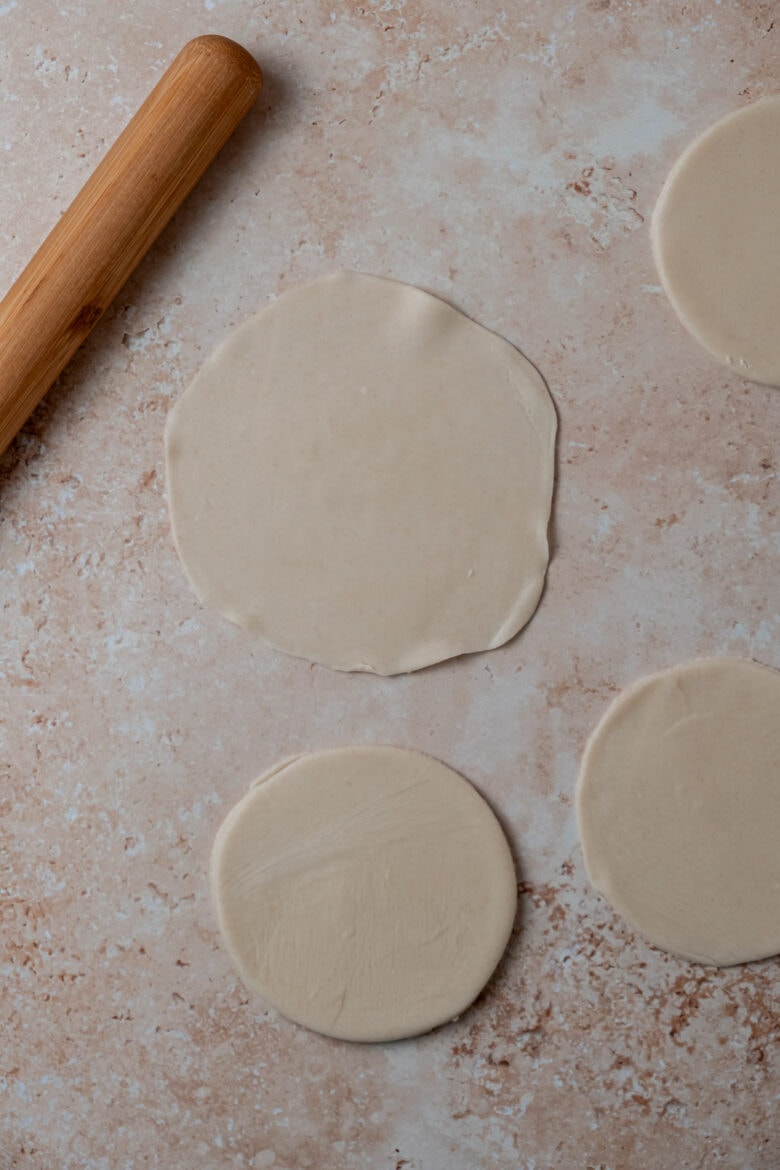
Step 6: Roll out the rounds a bit more. Use a rolling pin to roll out the rounds a bit more until they reach 5 inches (13 cm). Try to roll out the edges to be quite thin and leave the center of the dough a bit thicker.
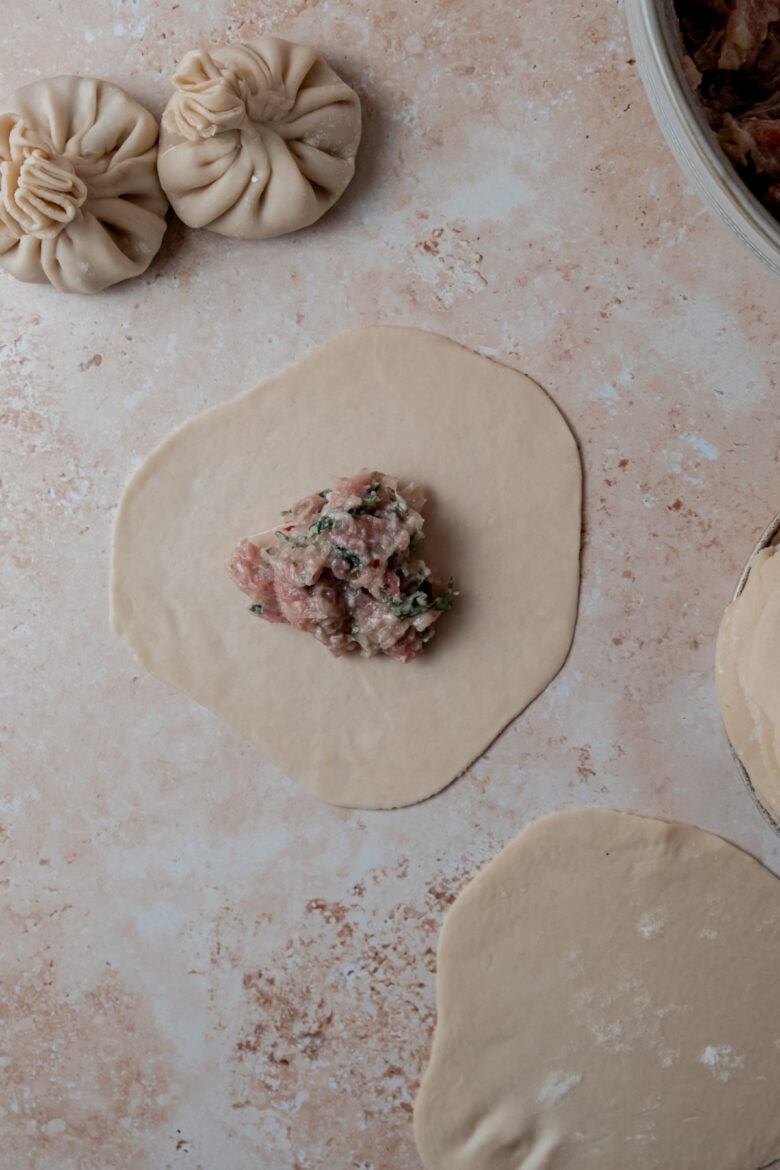
Step 7: Place two tablespoons of filling on a dough circle. You may need to adjust the amount if your Khinkali are a bit smaller or bigger. Use the first Khinkali as a test and adjust for the next dumplings.
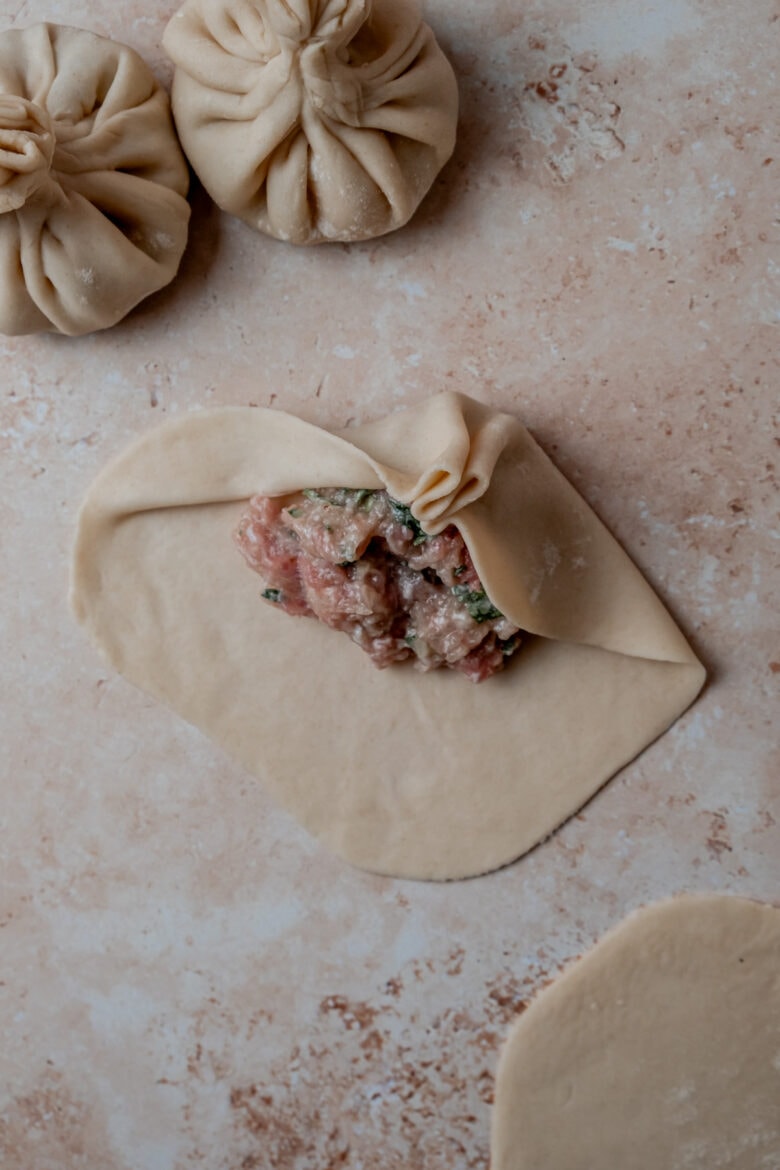
Step 8: Pleat the Khinkali. Bring the dough up around the filling to form a little pouch. Begin pleating the dough in a circular motion.
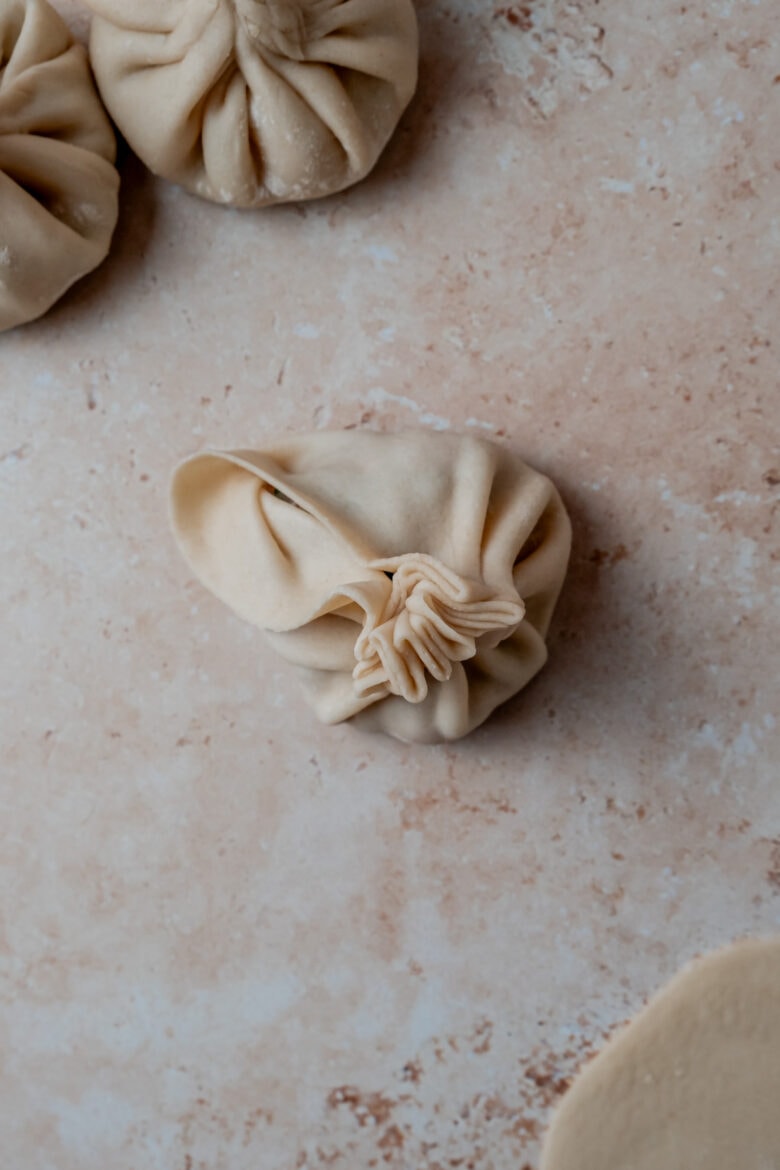
Step 9: Continue pleating the Khinkali until sealed. It’s said that Khinkali should have at least 19 folds, but I generally stop counting after the first Khinkali.
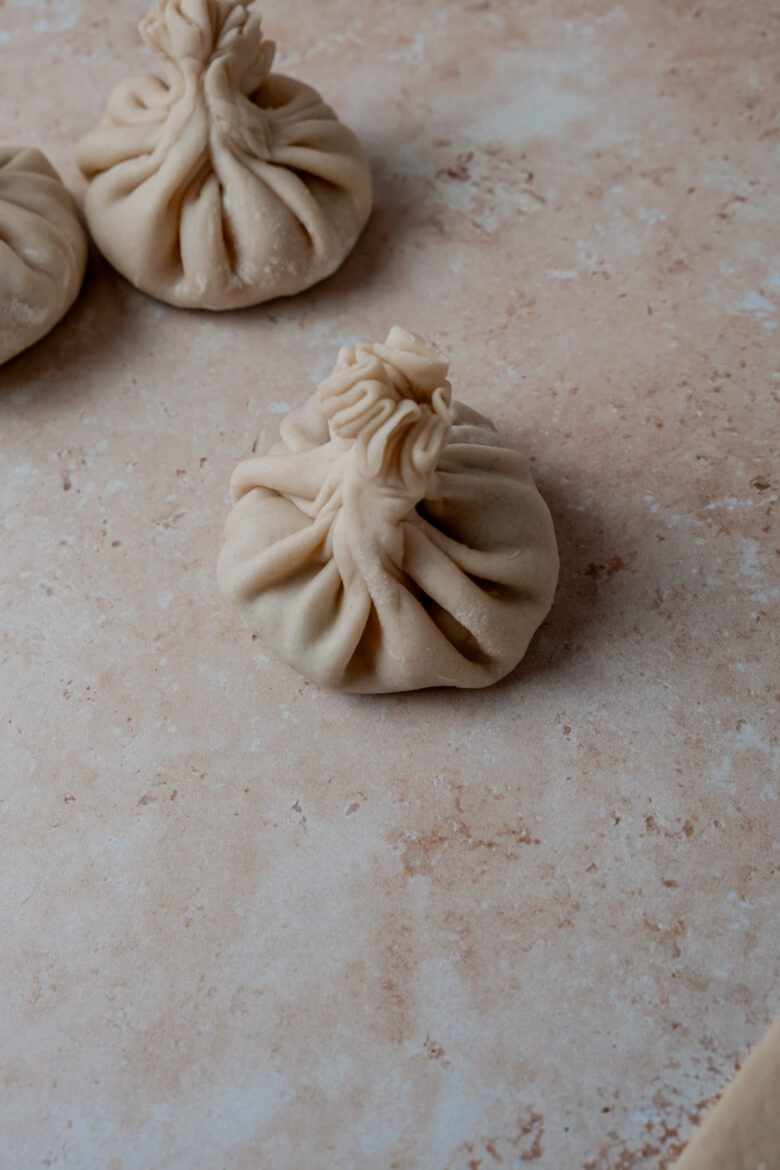
Step 10: Pinch to seal. Pinch the dough together about xx inch from the edges of the Khinkali to make sure you don’t lose any delicious broth during cooking.
Storage
Do not store uncooked Khinkali in the refrigerator, as they filling will seep into the dough, causing it to become soggy. It’s best to cook Khinkali immediately or store in the freezer.
Leftover cooked Khinkali can be stored in an airtight container in the refrigerator for 3-4 days. To reheat leftover Khinkali, I often fry them in a pan with a bit butter until warmed through.
Freezing instructions
Uncooked Khinkali can be frozen by following these easy steps:
- Line a pan with parchment paper and sprinkle with flour.
- Place the formed Khinkali on the pan in a single layer, making sure they are not touching.
- Place in the freezer for 1-2 hours or until frozen solid.
- Transfer the Khinkali to a freezer-safe bag or container for up to three months.
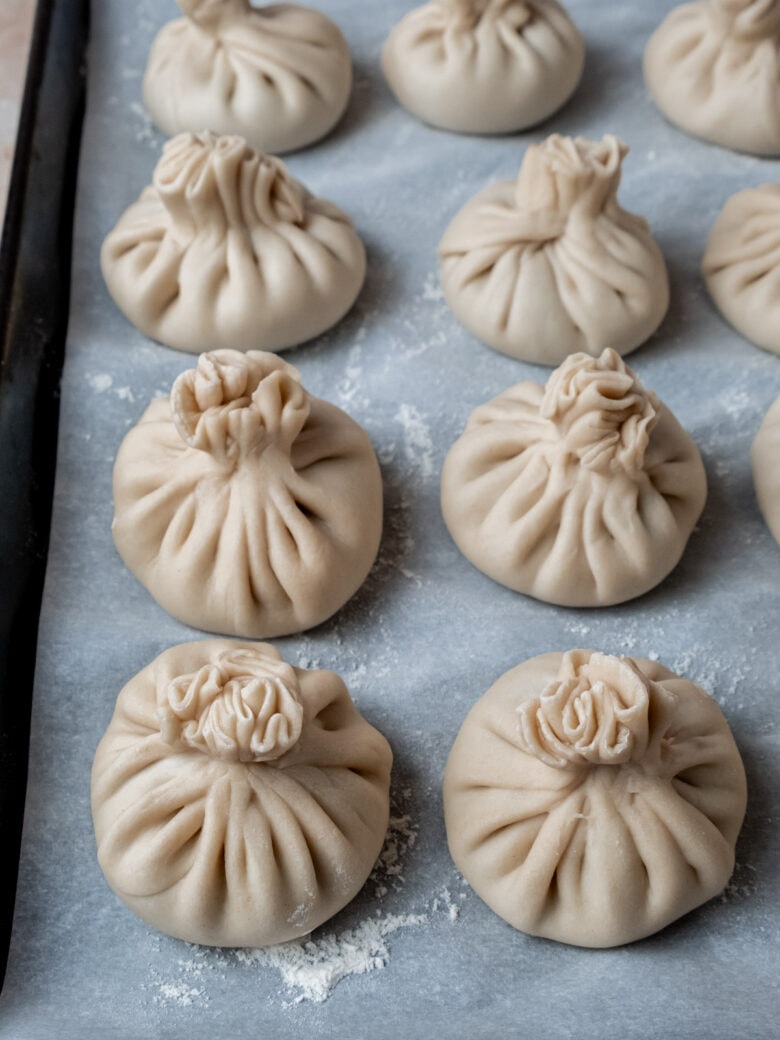
FAQs
Khinkali are traditional Georgian dumplings. They can be made with a variety of fillings, but the most popular is ground meat. The have a distinct shape which looks like a small pouch with a pleated top.
Your Khinkali should have 19 folds – the traditional mark of a true Khinkali master. But don’t sweat it if you have less — they’ll still taste amazing.
First of all – let the dumplings cool down a little, as they are filled with hot broth. Hold the “tail” of the Khinkali with your hands or a fork. Take a small bite out of the side and drink the hot broth. Eat the rest of the Khinkali, discarding the tail (which can be tough or undercooked).
Yes, uncooked Khinkali can be frozen for up to 3 months. Line a pan with parchment paper, sprinkle with flour, and place the formed Khinkali in a single layer without touching. Freeze for 1-2 hours until solid, then transfer to a freezer-safe container.
More Georgian-inspired recipes
Print
Khinkali Recipe
- Total Time: 3 hours 12 minutes
- Yield: 24
- Prep Time: 1 hour
- Rest Time: 2 hours
- Cook Time: 12 minutes
- Category: Dinner
- Method: Dumplings
- Cuisine: Georgian
Ingredients
Dough
- 4 cups (500 grams) all purpose flour, spooned and leveled*
- 1 teaspoon kosher salt
- 1 cup (240 ml) warm water
Filling
- ½ pound (225 grams) ground beef
- ½ pound (225 grams) ground pork
- 1 large yellow onion, grated with liquid*
- 1 bunch (40 grams) cilantro, chopped (use leaves and thin stems)
- 1 ¼ teaspoon kosher salt
- ¼ teaspoon ground caraway seed (optional)
- ½ teaspoon red pepper flakes
- ½ cup water, room temperature
Instructions
Dough
- In the bowl of a stand mixer fitted with a dough hook, combine the flour and salt. Briefly mix to evenly distribute the salt. To make the dough by hand, see recipe notes.
- With the mixer on low speed, gradually add the warm water. Once the dough comes together, increase speed to medium-low and continue mixing 10 minutes. The dough will be quite firm and a bit rough.
- Cover the dough tightly and let rest at room temperature for two hours. This resting period allows the gluten to relax, making the dough smoother and easier to work with.
Filling
- Combine the ground beef, ground pork, grated onion, cilantro, salt, caraway (if using) and pepper flakes in a large mixing bowl.
- Pour in the room temperature water and knead with your hands until the filling has absorbed the water.
Assembly
- Divide the dough in half. Roll out the dough to about ⅛-inch (3mm) thickness. NOTE: Make sure to keep any dough you’re not working with covered with a kitchen towel so it doesn’t dry out.
- Cut out 3.5 inch (9 cm) circles using a cookie cutter or the rim of a glass. Re-roll the scraps of dough and cut out more circles. Use a rolling pin to roll each circle into a larger circle of about 5 inches (13 cm). It helps to make the center of the circle thicker and the edges thinner.
- Working with one piece of dough at a time, place 2 tablespoons of filling in the center of the dough circle. Gather the edges of the dough, almost like forming a pouch, and begin pleating the dough. Pinch the Khinkali together to seal. Optional: If you have a lot of excess dough, you can use kitchen scissors to trim the ends.
- Transfer the Khinkali to a parchment paper-lined pan lightly dusted with flour. Repeat steps 1-5 with the second half of dough.
Cooking
- Bring a large pot of salted water to boil.
- Place the Khinkali in the water and cook for 10-12 minutes, stirring occasionally.
- Drain the dumplings and transfer to a plate. Allow to sit for several minutes before digging in — the broth will be hot!
Notes
Measuring flour: I recommend using a kitchen scale to measure flour. If measuring by volume, use the spoon and level method to avoid over-measuring the flour. Lightly spoon flour into the measuring cup until it’s completely full. Then run the back of a knife over the cup to gently scrape off any excess.
Yellow onion: Instead of grating, you can use your food processor to very finely mince the onion.
To make dough by hand: If making the dough by hand, you’ll need to knead it for 15-20 minutes. The dough is quite firm, so it takes a bit of muscle!
Storage: Leftover cooked Khinkali can be stored in an airtight container in the fridge for 3-4 days.
Freezing instructions: Transfer the formed Khinkali to a pan lined with parchment paper and dusted with flour. Make sure the Khinkali aren’t touching. Place them in the freezer for 1-2 hours or until frozen solid, then transfer to a freezer-safe bag or container.
This post may contain affiliate links through which we may earn a small commission at no additional cost to you. We only recommend products that we genuinely love and would use ourselves.
